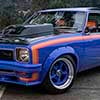I was reading a tori mag a while ago and read that the race tori's went to extreme lengths to save weight. To the point where the welds were even cut back. Instead of a solid weld all the way down a join they would weld for 2 inches or so then leave a 2 inch gap and weld again. Surprising how much weight can be saved by cutting back on welds. Not that you could do it on a street car, well you could but if you had to get a road worthy Im sure they would not pass it. Things like intrusion bars were not used either as they had roll cages. They are more ways they saved on weight, I just cant remember.
GO TORIES!!! 
Don't think that's the case. Most welds on car bodies of that era were spot welds, in which no extra weld metal is added. The article was probably referring to the 'seam welding' on the race cars, where extra short welds were added along the body seams. This extra welding was not done on road cars.
They are intentionally short welds and not a continuous weld along the seam for two reasons - one being that the shell still needs to have some flexibility, or the actual sheetmetal may tear. The second is that if a weld develops a crack, it will eventually work its way through the entire weld. Much better to lose one short, small weld than one dirty great long contunuous weld.
Back in the '70's, racing was a lot less technical that today, and I'd doubt if any really big efforts were made to lighten the shells too much, apart from slightly lighter sheetmetal to make the panels, less paint, and deleting the body sealant. Then again, I've seen some aluminium front guards on some highly placed Group C Falcons, and have heard of aluminium doors and guards for L34s too. Looking back, maybe the driver's diets would have been the place to start






 View Garage
View Garage








